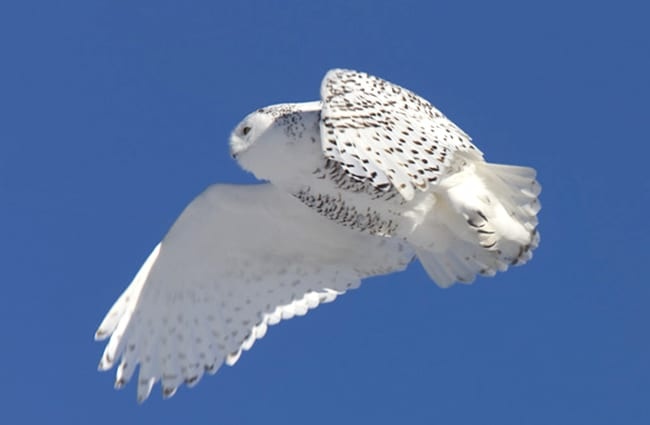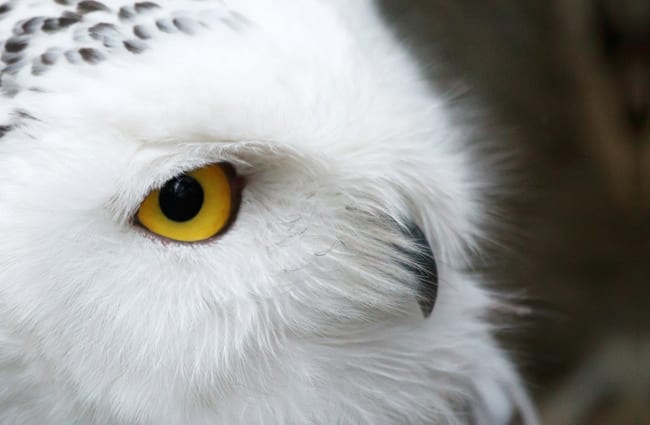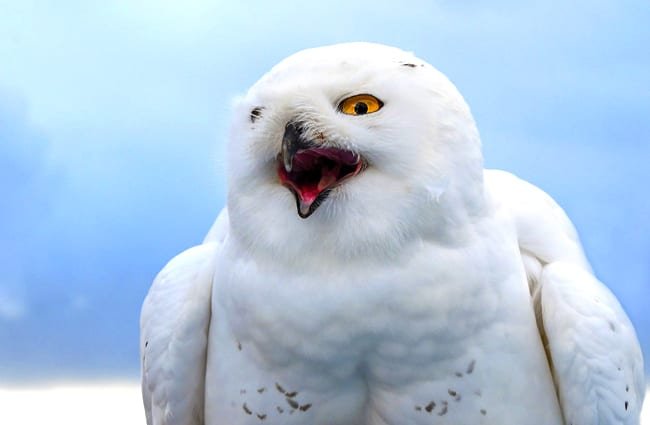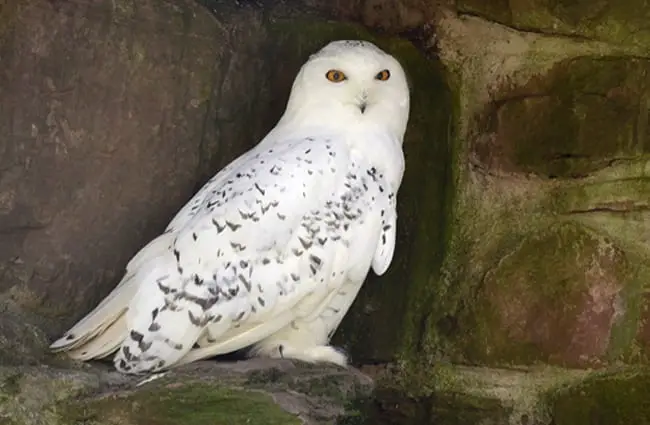The Ghost of the Tundra: Unveiling the Magnificent Snowy Owl
Imagine a creature born of ice and wind, a silent hunter whose very presence evokes the raw, untamed spirit of the Arctic. This is the Snowy Owl, a bird of breathtaking beauty and formidable prowess, often appearing as if a piece of the frozen landscape itself has taken flight. From its piercing yellow eyes to its pristine white plumage, the Snowy Owl is an icon of the polar regions, a master of survival in one of Earth’s most challenging environments. Join us on an exploration of this enigmatic raptor, delving into its life, its role in the ecosystem, and its enduring appeal to humans.

A Portrait of the Arctic Hunter: Basic Biology and Identification
Physical Characteristics
The Snowy Owl, scientifically known as Bubo scandiacus, is one of the largest owl species in North America and among the heaviest. Adults typically stand between 20 and 28 inches (50-70 cm) tall with an impressive wingspan that can reach up to 5 feet (1.5 meters). Their most striking feature is, of course, their plumage. Males are often almost pure white, becoming whiter with age, while females and younger birds display varying amounts of dark barring and spotting, which provides excellent camouflage against rocky tundra and sparse vegetation. This sexual dimorphism is a key identifier.
Their large, bright yellow eyes are fixed in their sockets, meaning the owl must turn its head almost 270 degrees in either direction to survey its surroundings. Beneath their feathers, Snowy Owls possess an incredibly dense layer of down and feathers, providing superior insulation against the brutal Arctic cold. Their legs and feet are also heavily feathered, acting like snowshoes and protecting them from frostbite. Unlike many nocturnal owls, Snowy Owls are primarily diurnal, especially during the continuous daylight of the Arctic summer, though they will hunt at any hour.

Home on the Frozen Frontier: Snowy Owl Habitat and Range
The natural habitat of the Snowy Owl is the vast, treeless Arctic tundra that encircles the globe. This includes regions across North America, Europe, and Asia. They prefer open landscapes, such as rolling hills, coastal dunes, and expansive plains, which offer unobstructed views for hunting and nesting. During the breeding season, they remain in the high Arctic, but as winter approaches and food becomes scarce, many Snowy Owls embark on southward migrations. These movements are often irregular and are known as “irruptions,” occurring when lemming populations in the Arctic crash, forcing the owls to seek prey further south.
During these irruptions, Snowy Owls can be found in a surprising array of environments far from their typical Arctic home. They might appear in open grasslands, agricultural fields, coastal beaches, airport fields, and even urban parks across southern Canada and the northern United States. These wintering grounds provide crucial hunting opportunities, though they are temporary residences.
Where to Find a Snowy Owl in the Wild
For the dedicated animal lover or aspiring zoologist hoping to witness a Snowy Owl, patience and preparation are paramount. During winter irruptions, look for large, open areas that mimic their tundra home: expansive fields, coastal dunes, airport perimeters, and even large, flat rooftops. They often perch on fence posts, hay bales, utility poles, or even directly on the ground, blending remarkably well with snow-covered landscapes. Early morning or late afternoon are often the best times for observation. Always bring good binoculars or a spotting scope to maintain a respectful distance. Key regions for winter sightings include the Great Lakes states, the Northeast United States, and the Canadian prairies. Checking local birding reports and eBird can provide up-to-date information on recent sightings.

The Arctic’s Apex Predator: Diet and Hunting Strategies
The Snowy Owl is a formidable predator, perfectly adapted to its role at the top of the Arctic food chain. Its diet is overwhelmingly dominated by lemmings, small rodents that populate the tundra in cyclical booms and busts. A single Snowy Owl can consume three to five lemmings per day, or even more during nesting season when feeding young. When lemming populations are low, the owls become opportunistic hunters, preying on a variety of other small mammals and birds. This can include voles, mice, hares, ptarmigan, ducks, and even larger birds like geese if the opportunity arises. They have been observed hunting fish and carrion as well, demonstrating their adaptability.
Their hunting strategy is a marvel of efficiency. With exceptional eyesight and hearing, they can detect prey from great distances, even under a layer of snow. They typically hunt from a perch or by flying low over the ground, then swooping down with powerful, silent flight to snatch their unsuspecting quarry. Their sharp talons are perfectly designed to grip and dispatch prey, while their strong, hooked beak tears flesh. They often swallow smaller prey whole, later regurgitating pellets of indigestible fur and bones.
Ecosystem Role
As a key predator, the Snowy Owl plays a vital role in regulating lemming and other small rodent populations, preventing overgrazing and maintaining the delicate balance of the tundra ecosystem. Their population fluctuations are often directly tied to lemming cycles, making them an important indicator species for the health of the Arctic environment. A decline in Snowy Owl numbers can signal broader ecological issues within their range.

Life in the Land of the Midnight Sun: Mating and Reproduction
Snowy Owls typically breed in the high Arctic during the brief summer months, from May to September. Courtship involves aerial displays by the male, including carrying prey to the female and bowing rituals. Once a pair bonds, the female selects a nesting site, usually a raised mound or hummock on the tundra, providing good visibility and drainage. She scrapes a shallow depression in the ground, often lining it with moss and her own feathers.
The clutch size is remarkably variable, directly correlating with the abundance of lemmings. In years of high lemming populations, a female may lay as many as 7 to 11 eggs, sometimes even more. In lean years, she might lay only 3 to 5 eggs, or not breed at all. This reproductive flexibility is a crucial adaptation to the unpredictable Arctic food supply. Incubation, primarily by the female, lasts about 32-34 days. The male provides food for the female and later for the hatchlings. The young owls, covered in white down, fledge at around 50-60 days old, though they may leave the nest earlier and wander nearby while still being fed by their parents. Both parents are fiercely protective of their nest and young, often dive-bombing intruders, including Arctic foxes and even humans.

Evolutionary Journey: Adapting to the Extreme North
The Snowy Owl’s evolutionary path is a testament to natural selection’s power in extreme environments. While the precise lineage of Bubo scandiacus is still debated among ornithologists, it is understood to have diverged from other owl species, developing specialized adaptations to thrive in the frigid, open landscapes of the Arctic. Its dense plumage, including feathers on its legs and feet, is a prime example of thermal adaptation, minimizing heat loss. The ability to hunt during daylight hours is another key evolutionary trait, allowing it to capitalize on the continuous daylight of the Arctic summer, unlike many other owl species that are strictly nocturnal.
Their acute senses, particularly their vision and hearing, are finely tuned for detecting subtle movements and sounds across vast, open terrain. The silent flight, characteristic of most owls due to specialized feather structures, is particularly advantageous in the quiet Arctic, allowing for surprise attacks on wary prey. These adaptations collectively showcase a remarkable evolutionary journey, shaping the Snowy Owl into the iconic Arctic survivor observed today.
Snowy Owls and Their Neighbors: Interspecies Interactions
In the harsh Arctic, interactions between species are often a matter of survival. Snowy Owls are apex predators, but they are also part of a complex web of life. Their primary prey, lemmings, are central to this dynamic, influencing the populations of not only Snowy Owls but also Arctic foxes, weasels, and various raptors. When lemming numbers crash, these predators must compete more fiercely for alternative food sources, leading to increased interspecies competition.
Snowy Owls are known to defend their nests vigorously against predators like Arctic foxes, often driving them away with powerful dives and vocalizations. They may also interact with other bird species; for instance, they can prey on smaller shorebirds and waterfowl, but larger raptors like Golden Eagles might occasionally compete for territory or prey. Despite their formidable presence, Snowy Owls generally maintain a solitary existence outside of the breeding season, minimizing direct interaction with most other animals unless it involves hunting or defense.
The Snowy Owl in Human Culture and Interaction
Cultural Significance
The striking appearance and elusive nature of the Snowy Owl have long captivated human imagination. In various indigenous cultures of the Arctic, the owl holds significant spiritual meaning, often revered as a wise and powerful spirit animal. Its silent flight and watchful eyes have made it a symbol of mystery, wisdom, and keen observation. In modern popular culture, the Snowy Owl gained widespread recognition as Hedwig, Harry Potter’s loyal companion, cementing its image as an intelligent and majestic creature in the minds of millions globally.
Encountering a Snowy Owl in the Wild: A Hiker’s Guide
For hikers and nature enthusiasts fortunate enough to encounter a Snowy Owl, it is a truly unforgettable experience. However, it is crucial to prioritize the bird’s well-being. Always maintain a respectful distance, typically at least 100 yards (90 meters), to avoid disturbing the owl. Use binoculars or a spotting scope for closer views. Never approach an owl, as this can cause stress, force it to expend valuable energy, or even abandon a hunting opportunity. Do not attempt to feed it, as this can habituate wildlife to humans and lead to detrimental outcomes. Observe quietly, appreciate its beauty, and leave no trace of your presence. If an owl appears agitated (e.g., staring intently, bobbing its head, or flying away), you are too close.
Conservation Status and Human Impact
While Snowy Owls have a vast range, their conservation status is currently listed as “Vulnerable” by the IUCN. The primary threats they face include climate change, which impacts their Arctic habitat and prey availability, and human disturbance. Oil and gas exploration, habitat degradation, and collisions with vehicles and power lines during their southward migrations also pose risks. Conservation efforts focus on understanding their migration patterns, protecting their breeding grounds, and mitigating human-caused mortality. Supporting organizations that conduct Arctic research and advocate for climate action is vital for the long-term survival of this magnificent species.

Caring for the Arctic Ambassador: A Zookeeper’s Guide to Snowy Owl Care
Caring for Snowy Owls in captivity requires a deep understanding of their natural history and specialized needs. Zookeepers play a crucial role in ensuring their welfare and contributing to conservation education.
-
Enclosure Requirements:
- Spacious aviaries are essential, providing ample flight room.
- Enclosures must be designed to withstand cold temperatures, though Snowy Owls are remarkably tolerant of cold. Protection from extreme heat is more critical in warmer climates.
- Provide varied perching options at different heights and materials (e.g., natural branches, platforms) to promote foot health and enrichment.
- Substrate should be easy to clean and appropriate for raptors, such as sand or natural ground.
-
Diet:
- A captive diet should mimic their natural prey as closely as possible. This typically includes whole rodents (mice, rats), chicks, and sometimes rabbits.
- Diet should be varied to ensure complete nutrition.
- Supplements, such as calcium and vitamin D3, may be necessary, especially for growing birds or breeding pairs, under veterinary guidance.
- Food should be offered in a way that encourages natural hunting behaviors, such as scattering it or placing it in different locations.
-
Enrichment:
- Environmental enrichment is vital for physical and mental stimulation. This can include novel perches, puzzle feeders, ice blocks in warmer weather, and rotating toys.
- Opportunities for bathing, such as shallow water dishes, should be provided.
-
Health Monitoring:
- Regular veterinary check-ups, including weight monitoring, feather condition assessment, and fecal analysis, are crucial.
- Keepers should be vigilant for signs of illness or injury, such as lethargy, changes in appetite, or abnormal droppings.
-
What to Avoid:
- Avoid sudden loud noises or rapid movements near the enclosure, which can startle the owls.
- Do not offer processed human foods or an unvaried diet.
- Avoid overcrowding or housing incompatible individuals, as Snowy Owls are generally solitary.
- Minimize direct human interaction to prevent habituation, unless necessary for training or medical procedures.
Fascinating Facts About Snowy Owls
- Snowy Owls are one of the few owl species that are primarily diurnal, especially during the Arctic summer’s continuous daylight.
- Their scientific name, Bubo scandiacus, translates roughly to “Scandinavian owl,” reflecting early observations in northern Europe.
- A Snowy Owl’s hearing is so acute it can detect a lemming moving beneath a foot of snow.
- They have a unique call, a deep, resonant hoot, but also produce barks, hisses, and clacking sounds.
- The amount of dark barring on a Snowy Owl’s plumage can indicate its age and sex, with older males being the whitest.
- Snowy Owls do not build elaborate nests; they simply scrape a shallow depression on the ground.
- Their population numbers are highly cyclical, mirroring the boom and bust cycles of their primary prey, lemmings.
- During irruption years, Snowy Owls can travel thousands of miles south from their Arctic breeding grounds.
- They are incredibly patient hunters, sometimes waiting for hours for the perfect moment to strike.
- The Snowy Owl is the official bird of Quebec, Canada.
Conclusion: A Call to Appreciation
The Snowy Owl stands as a magnificent testament to nature’s resilience and adaptive power. From its breathtaking beauty to its masterful hunting skills and its crucial role in the Arctic ecosystem, this bird embodies the wild spirit of the frozen north. Understanding its life cycle, its challenges, and its interactions with both its environment and humanity fosters a deeper appreciation for the intricate web of life. As we continue to learn more about these “ghosts of the tundra,” it becomes ever clearer that their survival is intertwined with the health of our planet, urging us to protect the pristine landscapes they call home for generations to come.

![Red Angus Closeup of a beautiful Red Angus cowPhoto by: U.S. Department of Agriculture [pubic domain]https://creativecommons.org/licenses/by/2.0/](https://animals.net/wp-content/uploads/2020/03/Red-Angus-4-238x178.jpg)




![Red Angus Closeup of a beautiful Red Angus cowPhoto by: U.S. Department of Agriculture [pubic domain]https://creativecommons.org/licenses/by/2.0/](https://animals.net/wp-content/uploads/2020/03/Red-Angus-4-100x75.jpg)

